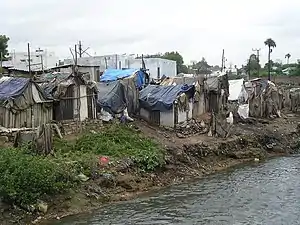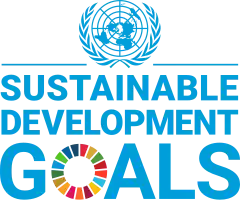Sustainable Development Goal 11
Sustainable Development Goal 11 (SDG 11 or Global Goal 11) is about "sustainable cities and communities" and is one of 17 Sustainable Development Goals established by the United Nations General Assembly in 2015. The SDG 11 is to "Make cities inclusive, safe, resilient and sustainable".[1] The 17 SDGs take into account that action in one area will affect outcomes in other areas as well, and that development must balance social, economic and environmental sustainability.[2] The targets of SDG 11 include investment in public transport, creating green public spaces, and improving urban planning and management in participatory and inclusive ways.
| Sustainable Development Goal 11 | |
|---|---|
 | |
| Mission statement | "Make cities and human settlements inclusive, safe, resilient, and sustainable" |
| Commercial? | No |
| Type of project | non-profit |
| Location | Global |
| Owner | Supported by United Nation & Owned by community |
| Founder | United Nations |
| Established | 2015 |
| Website | sdgs |
SDG 11 has 10 targets to be achieved, and this is being measured with 15 indicators. The seven "outcome targets" include: Safe and affordable housing, affordable and sustainable transport systems; inclusive and sustainable urbanization; protect the world's cultural and natural heritage; reduce the adverse effects of natural disasters; reduce the environmental impacts of cities; provide access to safe and inclusive green and public spaces. The three "means of achieving" targets include: Strong national and regional development planning; implement policies for inclusion, resource efficiency and disaster risk reduction; support least developed countries in sustainable and resilient building.[1][3]
In 2018, 4.2 billion people, or 55 percent of the world's population, lived in cities. By 2050, the urban population is expected to reach 6.5 billion.[4] Sustainable development cannot be achieved without significantly transforming the way we build and manage our urban spaces.[4] The world's cities occupy just 3 per cent of the Earth's land, but account for 60–80 per cent of energy consumption and 75 per cent of carbon emissions.[5] Thus cities are both an important cause for and solution to climate change.
The number of slum dwellers reached more than 1 billion in 2018, or 24 per cent of the urban population.[6] The number of people living in slums or informal settlements is highest in Eastern and South-Eastern Asia, sub-Saharan Africa and Central and Southern Asia.[6] In 2019, only half of the world's urban population had convenient access to public transport, defined as living within 500 meters' walking distance from a low-capacity transport system (such as a bus stop) and within 1 km of a high-capacity transport system (such as a railway).[6] In the period 1990–2015, most urban areas recorded a general increase in the extent of built-up area per person. Many regions recorded a consistent increase in the built-up area per capita, with Australia and New Zealand recording the highest values.[6]
Background
The Sustainable Development Goals (SDGs) are a collection of 17 global goals designed to be a "blueprint to achieve a better and more sustainable future for all". They address the global challenges we face, including those related to poverty, inequality, climate change, environmental degradation, peace and justice.[7]
SDG 11 is about improving cities and making them more sustainable. This requires several things, such as creating career and business opportunities, safe and affordable housing, and building resilient societies and economies.[4] Further examples include: investment in public transport, creating green public spaces, and improving urban planning.[4]
"By 2050, two-thirds of all humanity 6.5 billion people will be in urban areas. Sustainable development cannot be achieved without significantly transforming the way we build and manage our urban spaces, according to the United Nations."[4]
The unprecedented growth of cities a result of the rising number of the mass movement in and out of a geographical location has led to a boom in mega-cities, especially in the developing world, and slums are becoming a more significant feature of urban life.[4]
Between 2000 and 2014, the proportion of people living in slums fell from 39 percent to 30 percent. However, the absolute number of people living in slums went from 792 million in 2000 to an estimated 880 million in 2014. Movement from rural to urban areas has accelerated as the population has grown and better housing alternatives are available.[8]
Targets, indicators and progress

The UN has defined 10 targets and 15 indicators for SDG 11.[9] Targets specify the goals, and indicators represent the metrics by which the world aims to track whether these targets are achieved. Six of them are to be achieved by the year 2030 and one by the year 2020 and three have no target years. Each of the targets also has one or two indicators which will be used to measure progress.
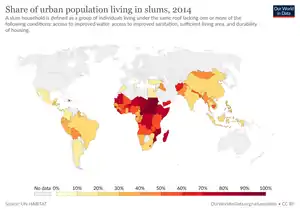
Target 11.1: Safe and affordable housing
The full title of Target 11.1 is "By 2030, ensure access for all to adequate, safe and affordable housing and basic services and upgrade slums".[1]
This target has one Indicator: Indicator 11.1.1 is the "Proportion of the urban population living in slum households".
People who live in slums have no access to improved water, access to improved sanitation, sufficient living area, and durable housing.[9]
Target 11.1 is to ensure access to safe and affordable housing by 2030. The indicator to measure progress toward this target is the proportion of urban population living in slums or informal settlements. Between 2000 and 2014, the proportion fell from 39 percent to 30 percent. However, the absolute number of people living in slums went from 792 million in 2000 to an estimated 880 million in 2014. Movement from rural to urban areas has accelerated as the population has grown and better housing alternatives are available.[8]
The number of slum dwellers reached more than 1 billion in 2018, or 24 per cent of the urban population.[6] The number of people living in urban slums is highest in Eastern and South-Eastern Asia, sub-Saharan Africa and Central and Southern Asia.[6]
Target 11.2: Affordable and sustainable transport systems

The full text of Target 11.2 is "By 2030, provide access to safe, affordable, accessible and sustainable transport systems for all, improving road safety, notably by expanding public transport, with special attention to the needs of those in vulnerable situations, women, children, persons with disabilities and older persons".[1]
This target has one Indicator: Indicator 11.2.1 is the "Proportion of population that has convenient access to public transport, by sex, age and Persons With Disabilities".[9]
In 2019, only half of the world's urban population had convenient access to public transport, defined as living within 500 meters' walking distance from a low-capacity transport system (such as a bus stop) and within 1 km of a high-capacity transport system (such as a railway).[6]
Target 11.3: Inclusive and sustainable urbanization
The full-text Target 11.3 is "By 2030, enhance inclusive and sustainable urbanization and capacity for participatory, integrated and sustainable human settlement planning and management in all countries".[1]
The target has two indicators:[9]
- Indicator 11.3.1: Ratio of land consumption rate to the population growth rate
- Indicator 11.3.2: Proportion of cities with a direct participation structure of civil society in urban planning and management that operate regularly and democratically
There are currently no data available for this indicator.[9]

Target 11.4: Protect the world's cultural and natural heritage
The full text of Target 11.4 is "Strengthen efforts to protect and safeguard the world's cultural and natural heritage."[1]
It has one indicator: Indicator 11.4.1 is the "Total per capita expenditure on the preservation, protection and conservation of all cultural and natural heritage, by the source of funding (public, private), type of heritage (cultural, natural) and level of government (national, regional, and local/municipal)".
This indicator can be difficult to calculate for the following reasons: Countries’ national accounting frameworks may not clearly separate cultural, natural, and other activities; financial transactions may be rechanneled for different uses; financial transactions may be double-counted at different levels of public administration.[10]
There are currently no data available for this indicator.[9]
Target 11.5: Reduce the adverse effects of natural disasters
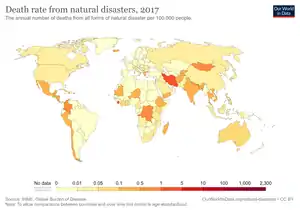
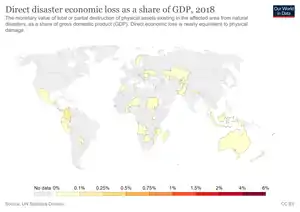
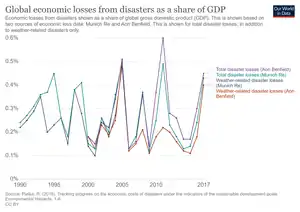
The full text of Target 11.5 is "By 2030, significantly reduce the number of deaths and the number of people affected and substantially decrease the direct economic losses relative to global gross domestic product caused by disasters, including water-related disasters, with a focus on protecting the poor and people in vulnerable situations".[1]
Indicators are:[9]
- Indicator 11.5.1: Number of deaths, missing persons and directly affected persons attributed to disasters per 100,000 population. Indicators measured here report mortality rates internally displaced persons, missing persons and total numbers affected by natural disasters
- Indicator 11.5.2: Direct economic loss in relation to global GDP, damage to critical infrastructure and the number of disruptions to basic services, attributed to disasters."
Target 11.6: Reduce the environmental impacts of cities
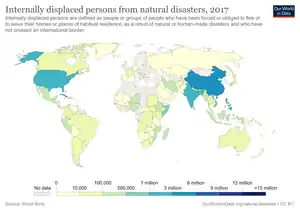
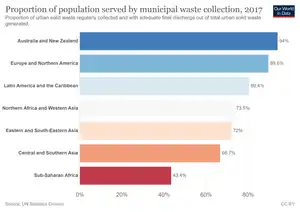
The full text of Target 11.6 is "By 2030, reduce the adverse per capita environmental impact of cities, including by paying special attention to air quality and municipal and other waste management."[1]
The target has two indicators:[9]
- Indicator 11.6.1: Proportion of municipal solid waste collected and managed in controlled facilities out of total municipal waste generated, by cities
- Indicator 11.6.2: Annual mean levels of fine particulate matter (e.g. PM2.5 and PM10) in cities (population weighted)
Particulate matter (PM) in the air can affect the cardiovascular system and other major organs. Chronic exposure will lead to further health risks.[11]
Target 11.7: Provide access to safe and inclusive green and public spaces
The full text of Target 11.7 is: “By 2030, provide universal access to safe, inclusive and accessible, green and public spaces, in particular for women and children, older persons and Persons With Disabilities"[1]
The two indicators include:
- The Indicator 11.7.1: Average share of the built-up area of cities that is open space for public use for all, by sex, age and persons with disabilities
- The Indicator 11.7.2: Proportion of person victim of physical or sexual harassment, by sex, age, disability status and place of occurrence, in the previous 12 months
Data collected in 2019 show that, in the period 1990–2015, most urban areas recorded a general increase in the extent of built-up area per person. Many regions recorded a consistent increase in the built-up area per capita, with Australia and New Zealand recording the highest values.[6]
Based on 2019 data from 95 countries, the share of land allocated to streets and open spaces averaged only about 16 percent globally.[6] Of those, streets accounted for about three times as much urban land as open public spaces, such as parks.[6]
Target 11.a: Strong national and regional development planning
The full text of Target 11.a is "Support positive economic, social and environmental links between urban, peri-urban and rural areas by strengthening national and regional development planning".[1]
It has one indicator: Indicator 11.a.1 is the "Number of countries that have national urban policies or regional development plans that (a) respond to population dynamics; (b) ensure balanced territorial development, and (c) increase local fiscal space."
This indicator is one of the key metrics to benchmark and monitors urbanization.[12] It can serve as a gap analysis to support policy recommendations.[12] Data sources for this indicator may include: Official documents such as National Urban Plan available in national and regional administrations, point of service surveys, database of national urban policies by United Nations, UrbanLex, a database of laws and policies on urban matters developed by UN-Habitat.[12]
There are currently no data available for this indicator.[9]
Target 11.b: Implement policies for inclusion, resource efficiency and disaster risk reduction
The full text of Target 11.b is "By 2020, substantially increase the number of cities and human settlements adopting and implementing integrated policies and plans towards inclusion, resource efficiency, mitigation and adaptation to climate change, resilience to disasters, and develop and implement, in line with the Sendai Framework for Disaster risk reduction 2015–2030, holistic disaster risk management at all levels."[1]
Unlike most SDGs which have the target year of 2030, this indicator is set to be achieved by 2020.
The two indicators include:[9]
- Indicator 11.b.1: Number of countries that adopt and implement national disaster risk reduction strategies in line with the Sendai Framework for Disaster Risk Reduction 2015–2030
- Indicator 11.b.2: Proportion of local governments that adopt and implement local disaster risk reduction strategies in line with national disaster risk reduction strategies
Target 11.c: Support least developed countries in sustainable and resilient building
The full text of Target 11.c is formulated as "Support least developed countries, including through financial and technical assistance, in building sustainable and resilient buildings utilizing local materials".[1]
This target has one Indicator: Indicator 11.c.1 is the "Proportion of financial support to the least developed countries that is allocated to the construction and retrofitting of sustainable, resilient and resource-efficient buildings utilizing local materials".
A proposal has been tabled in 2020 to delete Indicator 11.c.1.[13]
Custodian agencies
The custodian agencies are responsible for data gathering and reporting on the indicators:[14]
- For the indicators of Targets 11.1, 11.2 and 11.3 and also for Indicator 11.a.1 and Indicator 11.c.1: United Nations Human Settlements Programme (UN-HABITAT)
- For Indicator 11.4.1: United Nations Educational, Scientific, and Cultural Organization-Institute for Statistics (UNESCO-UIS)
- For the two indicators under Target 11.5 and for Indicator 11.b.2: United Nations International Strategy for Disaster Reduction (UNISDR)
- For Indicator 11.6.1: United Nations Human Settlements Programme (UN-HABITAT), Department of Economic and Social Affairs (DESA) and UNSD
- For Indicator 11.6.2: World Health Organization
Monitoring and Progress
High-level progress reports for all the SDGs are published in the form of reports by the United Nations Secretary General. The most recent one is from April 2020.[6] The report before that was from May 2019.[15]
In 2018, High-level Political Forum (HLPF) took stock of progress on the Sustainable Development Goals (SDGs).[16] One of the goals that was focused on was the eleventh SDGs, cities and human settlements.[16] They discussed progress, successes, challenges and lessons learned on the road to a fairer, more peaceful and prosperous world and a healthy planet by 2030.[16]
Challenges
Impacts of COVID pandemic
SDG 11 has proven to be of critical importance during the COVID-19 pandemic by ensuring a reduction in exposure to those living in crowded areas.[17] The pandemic has showed us that there still a challenge in our urban spacing as 90% cases are in this areas.[18]
Heritage is an important economic driver. Due to the COVID-19 pandemic in 2020, the culture sector has been hard hit and lost funding.[19]
Links with other SDGs
SDG 11 interlinks with many of the other SDGs. First, the impact on health (SDG 3, Target 3.9) of city dwellers, as well as improve cities resilience to natural and climate change-induced disasters. It is related to SDG 6 (target 6.1, 6.2 and 6.5), SDG 12 (target 12.4), SDG 14 (target 14.3) Lastly, reducing the impact of communicable diseases and maternal and children mortality which can be found under SDG 3 (targets 3.2 and 3.3).[20]
Furthermore, SDG 11 interlinks with SDG 13 on climate action: The world's cities account for 60–80 per cent of energy consumption and 75 per cent of carbon emissions (this is because 4.2 billion people, or 55 percent of the world's population, lived in cities in 2018).[4][5]
Organizations
UN system
- United for Smart Sustainable Cities Initiative (U4SSC) which has been pilot to monitor urban-environment related Sustainable Development Goals (SDGs) projects[21]
NGOs and others
The following NGOs and other organizations are helping to achieve SDG 11:
- GoFar founded by Danny Adams is a Sydney Founder Institute portfolio company. It helps to cut emissions produced by vehicles, as well as improve driver safety. GoFar has a unique app and in-car device that provides drivers with real-time feedback to help them reduce fuel consumption.[23]
- C40 cities is a network of the world's megacities committed to addressing climate change,[24] It is taking bold climate action and leading the way towards having a more sustainable future.[25] C40 also offers cities an effective forum to collaborate, share knowledge and drive meaningful action on climate change.[24]
- ICLEI is committed to sustainable urban development.[26] It helps members to make their cities and regions sustainable, low-carbon, resilient, ecomobile, biodiverse, resource-efficient and healthy, with a green economy and smart infrastructure.[24]
- 100RC developed by the Rockefeller Foundation helps cities around the world to become more resilient to physical, social, and economic shocks and stresses[27] and it supports the adoption and incorporation of a view of resilience that includes not just the shocks, earthquakes, fires, floods, but also the stresses that weaken the fabric of a city on a day to day or cyclical basis.[24]
See also
References
- United Nations (2017) Resolution adopted by the General Assembly on 6 July 2017, Work of the Statistical Commission pertaining to the 2030 Agenda for Sustainable Development (A/RES/71/313)
- "What are the Sustainable Development Goals?". United Nations Development Programme. Retrieved 6 September 2020.
- "Goal 11 Sustainable Cities and Communities". Africa UNDP Org. Retrieved September 20, 2020.
- "Goal 11: Sustainable cities and communities". United Nations Development Programme. Retrieved 6 September 2020.
- "Sustainable development goals".
- United Nations Economic and Social Council (2020) Progress towards the Sustainable Development Goals Report of the Secretary-General, High-level political forum on sustainable development, convened under the auspices of the Economic and Social Council (E/2020/57), 28 April 2020
- "About the Sustainable Development Goals". United Nations. Retrieved 6 September 2020.
- "Sustainable Development Goal 11". Sustainable Development Goals. 16 November 2017. Retrieved 16 November 2017.
- Ritchie, Roser, Mispy, Ortiz-Ospina. "Measuring progress towards the Sustainable Development Goals." (SDG 11) SDG-Tracker.org, website (2018)
- UNESCO (2019) Culture | 2030 Indicators, United Nations Educational, Scientific and Cultural Organization, Paris, France, ISBN 978-92-3-100355-4, CC-BY-ND 3.0 IGO
- "Urban air pollution – what are the main sources across the world?". EU SCIENCE HUB, The European Commission's science and knowledge service. 30 November 2015. Retrieved 7 September 2020.
- UN-Habitat (2018). SDG Indicator 11.a.1 Training Module: National Urban Policy. United Nations Human Settlement Programme (UN-Habitat), Nairobi.
- "IAEG-SDGs 2020 Comprehensive Review Proposals Submitted to the 51st session of the United Nations Statistical Commission for its consideration". United Nations, Department of Economic and Social Affairs, Statistics Division. Retrieved 1 September 2020.
- "United Nations sustainable Development Goal 11 Custodian Agency. 2018" (PDF). UNECE Org. Retrieved September 20, 2020.
- United Nations Economic and Social Council (2019) Special edition: progress towards the Sustainable Development Goals, Report of the Secretary-General (E/2019/68), High-level political forum on sustainable development, convened under the auspices of the Economic and Social Council (8 May 2019)
- "High Level Political Forum 2018 on Cities and Human Settlement". HPLP. Retrieved September 20, 2020.
- "SDGs still offer best option to reduce worst impacts of COVID-19 and to recover better".
- "The sustainable development reports 2020" (PDF).
- "Initial launch of the SDG Indicator 11.4.1 Survey on cultural and natural heritage expenditure". UNESCO Institute of Statistics. 26 June 2020. Retrieved 7 September 2020.
- "Visualisation map of the interlinkages between SDG 11 and the other SDGs" (PDF). ESCAP. Retrieved 7 September 2020.
- "United 4 Smart Sustainable Cities" (PDF). 2016.
- "United Nations sustainable Development Goal 11 Custodian Agency. 2018" (PDF). UNECE Org. Retrieved September 20, 2020.
- "17 Companies Helping Meet the 17 UN Sustainable Development Goals". The Founder Institute. Retrieved 2020-09-22.
- "NGOs-leading-SDGs-Sustainable-Brands" (PDF).
- "C40". c40.org. Retrieved 2020-09-22.
- "ICLEI". iclei.org. Retrieved 2020-09-22.
- "100 Resilient Cities". The Rockefeller Foundation. Retrieved 2020-09-22.
